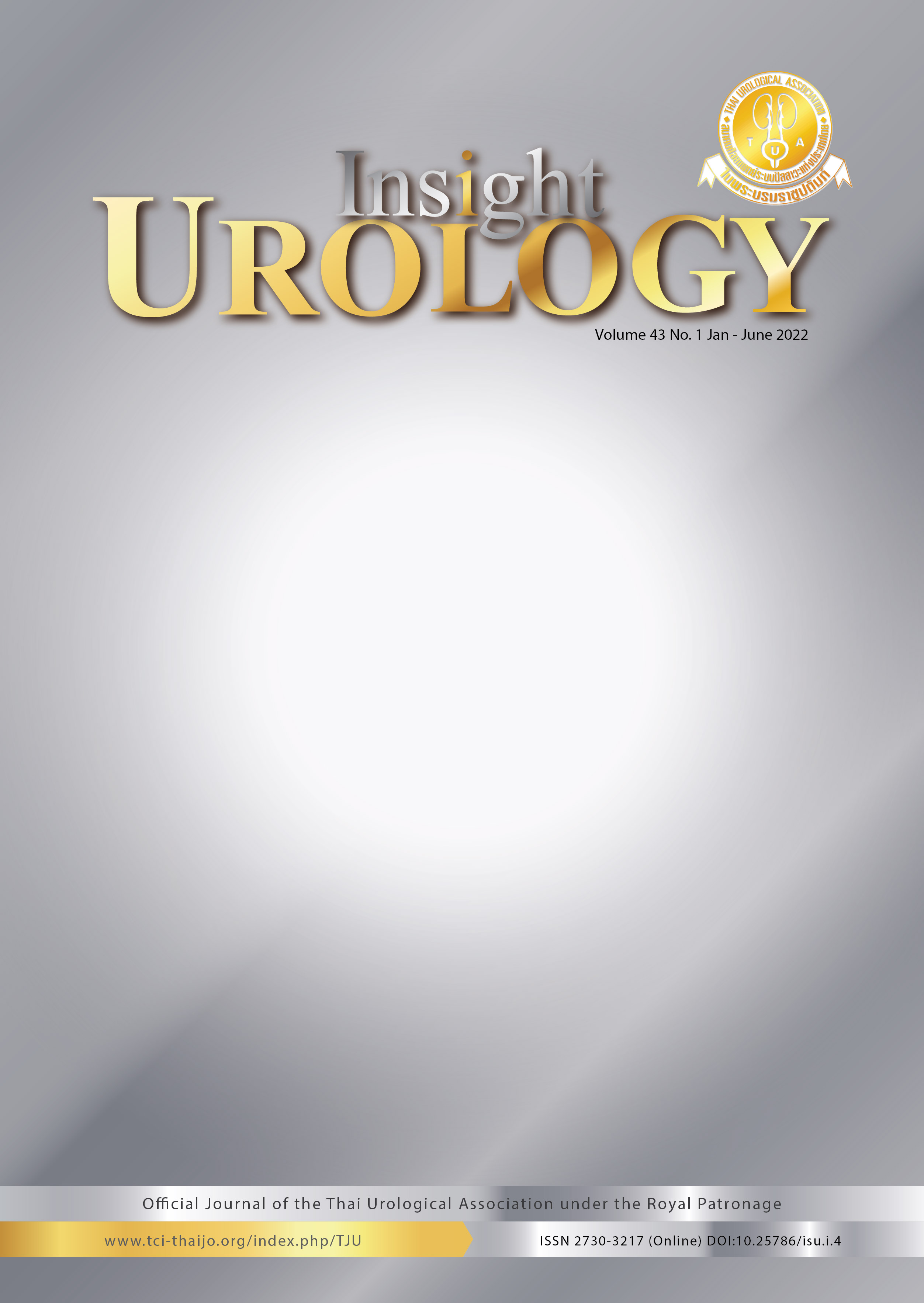Development and validation of a score for the screening of Loei urolithiasis patients
DOI:
https://doi.org/10.52786/isu.a.44Keywords:
Water spinach, Bamboo shoot, Laab/Koi, score, screening urolithiasisAbstract
Objective: To evaluate risk factors associated with stone formation and development and validation of a score for screening Loei urolithiasis patients.
Materials and Methods: This cross-sectional study included 1008 individuals, 466 of which were urolithiasis patients and 542 non-urolithiasis, with no history of stone and no evidence of stone from investigations at Loei Hospital between July 2014 and January 2019. This group was used effectively as a control group. Questionnaires were used to collect information regarding demographic parameters, food and water intake and frequency. The information was used to identify any associations with stone formation using logistic regression analysis. Univariable and multivariable analysis were carried out in order to build a predictive model for the likelihood of stone formation. The strength of the classifier from the predictive model was evaluated using the area under the receiver operating characteristics (ROC) curve.
Results: Multivariable analysis showed increasing BMI (adjusted odds ratio (aOR) =1.06; 95% CI: 1.01-1.1, p = 0.01); male gender (aOR = 2.09; 95%CI: 1.46-2.98, p < 0.001); family history of urolithiasis (a OR = 2.81; 95% CI: 1.78-4.42, p < 0.001); farmer (aOR = 3.59; 95% CI: 2.44-5.29, p < 0.001); working time > 8 hours/day (aOR = 2.19; 95%CI: 1.47-3.27, p < 0.001); drinking more than 2 liters per day of water (aOR = 1.58; 95%CI: 1.13-2.22, p = 0.01); always eat water spinach (aOR = 3.37; 95% CI: 1.47-7.74, p = 0.01); always eat bamboo shoots (aOR = 9.53; 95% CI: 4.54-19.99, p < 0.001); eat Laab/Koi (a local Thai spicy salad made of raw meat and fish) more than or equal to 3 times per week (aOR = 1.75; 95% CI: 1.05-2.9, p = 0.03) and drink bottled water (aOR = 0.17.; 95% CI: 0.12-0.24, p < 0.001) were statistically significant for stone formation. The predictive model for the likelihood of stone formation has a cut-off value greater than or equal to 0.46 for a sensitivity of 72.41%, a specificity of 79.52%, and area under the ROC curve of 0.83.
Conclusions: Increasing BMI, being of male gender, a family history of urolithiasis, farmers, working time > 8 hours/day, regular consumption of water spinach, regular consumption of bamboo shoots, eat Laab/Koi more than or equal to 3 times per week were associated significantly with stone formation. We developed and validated a predictive model to indicate the likelihood of stone formation, which can be utilized for the screening of Loei urolithiasis patients facilitating early detection and early treatment.
References
Yanagawa M, Kawamura J, Onishi T, Soga N, Kameda K, Sriboonlue P,et al. Incidence of urolithiasis in northeast Thailand. Int J Urol 1997;4:537-40.
Tosukhowong P, Boonla C, Ratchanon S, Tanthanuch M, Poonpirome K, Supataravanich P, et al. Crystalline composition and etiologic factors of kidney stone in Thailand: update 2007. Asian Biomedicine 2007;1:87-95.
Laohapan A, Nuwatkrisin K, Ratchanon S, Usawachintachit M. Study of urinary stone composition in a university-based hospital. Insight Urol 2020;41:48-56.
Tosukhowong P, Phansin P, Shotiksatit J, Selahapan N, Tungsahya K, et al. Study of organic acid and mineral contents in fruits and vegetables in north-eastern of Thailand and impact on nephrolithiasis. Research report quality of life improvement project. Chula Med J 1991;35:32-43.
Santanapipatkul K, Jantakun W, Tanthanuch M. Urinary tract stone analysis in Loei province. Thai J Urol 2019;40:9-18.
Liu Y, Chen Y, Liao B, Luo D, Wang K, Li H, et al. Epidemiology of urolithiasis in Asia. Asian J Urol 2018;5:205-14.
Aegukkatajit S. Epidemiology of stone diseases in north-eastern Thailand. In: Urolithiasis: current status. Proceeding of the 17th Academic Meeting of the Royal College of Surgeons of Thailand; 2003; Pattaya: Bangkok; 2003. p. 1-17.
Lamphetthapong C, ChuaSathuchon C, Pongparit N, Sanguanwongwan W, Jenwittaya T, Chaowaratet S, et al. The urinary tract stone disease in Ubonratchathani province. Med J Ubon Hosp 1993;14:17-8.
Fan J, Chandhoke PS, Grampsas SA. Role of sex hormones in experimental calcium oxalate nephrolithiasis. J Am Soc Nephrol 1999;10:S376-80.
Taylor EN, Stampfer MJ, Curhan GC. Obesity, weight gain, and the risk of kidney stones. JAMA 2005;293:455-62.
Semins MJ, Shore AD, Makary MA, Magnuson T, Johns R, Matlaga BR. The association of increasing body mass index and kidney stone disease. J Urol 2010;183:571-5.
Kim MS, Moon Y. The relationship between obesity and the risk factors of urolithiasis. Korean J Urol 2007;48:505-11.
Kerstetter J CB, O’Brien K, Wurtman R, Allen L. Mineral homeostasis in obesity: effects of euglycemic hyperinsulinemia. Metabolism 1991;40:707-13.
Curhan GC, Willett WC, Rimm EB, Stampfer MJ. Family history and risk of kidney stones. J Am Soc Nephrol 1997;8:1568-73.
Edvardsson VO, Ingvarsdottir SE, Palsson R, Indridason OS. Incidence of kidney stone disease in Icelandic children and adolescents from 1985 to 2013: results of a nationwide study. Pediatr Nephrol 2018;33:1375-84.
Taylor EN, Curhan GC. Diet and fluid prescription in stone disease. Kidney Int 2006;70:835-9.
Agarwal MM, Singh SK, Mavuduru R, Mandal AK. Preventive fluid and dietary therapy for urolithiasis: An appraisal of strength, controversies, and lacunae of current literature. Indian J Urol 2011;27:310-9.
Tosukhowong P, Borvonpadungkitti S, Prasongwatana V, Tungsanga K, Jutuporn S, Dissayabutr T, et al. Urinary citrate excretion in patients with renal stone: roles of leucocyte ATP citrate lyase activity and potassium salts therapy. Clin Chim Acta 2002; 325:71-8.
Tungsanga K, Sriboonlue P, Borwornpadungkitti S, Tosukhowong P, Sitprija V. Urinary acidification in renal stone patients from northeastern Thailand. J Urol 1992;147:325-8.
Downloads
Published
How to Cite
Issue
Section
License
Copyright (c) 2022 Insight Urology

This work is licensed under a Creative Commons Attribution-NonCommercial-NoDerivatives 4.0 International License.



